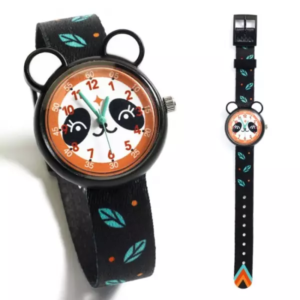In today’s fast-paced digital world, teaching kids how to read the time from an analog clock might seem quaint. After all, digital time displays are everywhere – from smartphones to microwave ovens. However, the ability to tell time using traditional clocks is a skill that goes beyond the face of a clock. It’s about empowering children with essential life skills, enhancing their cognitive abilities, and fostering a profound understanding of time.
In this article, we will explore the recommended age for children to start learning how to tell time, the advantages of analog clocks, and how engaging tools like Djeco watches and Janod Magneti’s can play a pivotal role in this educational journey.
The Right Age To Learn Time-Telling Skills
Parents often wonder when to introduce time-telling skills to their children. Here are some general guidelines:

- Early Awareness (Ages 4-5): Children develop a basic understanding of time, recognising morning, afternoon, and evening. This is an excellent time to introduce them to clocks and daily routines.
- Learning the Hour (Ages 6-7): Around ages 6-7, most children can grasp reading the hour on an analog clock. They understand the hour hand’s role in indicating time.
- Adding Minutes (Ages 8 and Beyond): By age 8 and beyond, children can progress to reading minutes on an analog clock. They learn to interpret both the hour and minute hands.
- Digital vs. Analog: While digital clocks are prevalent, starting with analog clocks is often recommended. They visually represent time’s passage and help children grasp fundamental time-telling concepts.
 Djeco – Ticlock Panda$34.99
Djeco – Ticlock Panda$34.99 Djeco – Ticlock Leaves$34.99
Djeco – Ticlock Leaves$34.99
Also Read: See How French Book Fairs are changing the School Experience for kids
Incorporating Time Into Everyday Life
Parents and educators can incorporate time into various aspects of a child’s daily life to further reinforce the concept of time. Here are some practical tips:
- Morning Routine: Teach kids to use the clock to follow their morning routine. Set specific times for waking up, getting dressed, and having breakfast.

- Time-Related Vocabulary: Introduce time-related words such as “hour,” “minute,” “second,” “morning,” “afternoon,” and “evening” into conversations.
- Time Games: Engage in fun time-related games like “What time will it be in 15 minutes?” or “Can you find all the clocks in the room?”
- Bedtime Routine: Use the clock to establish bedtime routines. Children can learn that bedtime is at a specific time each night.
- Calendar Learning: Encourage children to use calendars to mark important dates, events, and appointments. It helps them understand days, weeks, and months.
- Time for Fun: Set aside time for enjoyable activities, ensuring kids understand that time management allows for responsibilities and leisure.
Unlocking The Time-Telling Adventure: Why Kids Should Embrace The Clock?
Time is a mysterious journey; learning to tell is like a thrilling adventure. As kids grow and explore the world, understanding time becomes vital to their quest for knowledge and independence. Let’s explore the reasons why they must learn time-telling!
Always Good To Know How To Read The Time:
Understanding the concept of time is fundamental to our daily lives. While digital devices surround us, analog clocks remain relevant in various situations. Teaching kids to read the time from traditional clocks equips them with a timeless skill that can be valuable throughout their lives.
Digital Time Does Not Make Sense For Kids:
Digital clocks, although prevalent, may not help children grasp the deeper essence of time. Analog clocks, with their moving hands, establish a tangible connection between time and motion, making it easier for kids to comprehend the passage of time.

Regular Watches Have More Functions:
Beyond timekeeping, regular watches offer additional features such as displaying the date and other functions. Familiarising kids with regular watches allows them to appreciate these added functionalities, nurturing a holistic understanding of timepieces.
Also Read: Beat the Holiday Rush: Shop Early with My Bulle Toys!
Help Them Understand The Daily Schedule:
One of the most practical aspects of learning to tell time is that it enables kids to understand their daily schedules better.
- Sale Product on sale
 Janod – Essential – Learn to tell the time
Janod – Essential – Learn to tell the time$30.99Original price was: $30.99.$15.00Current price is: $15.00.
They can manage their routines more efficiently as they become proficient in interpreting time. Understanding when it’s time to wake up, eat meals, attend school, and engage in recreational activities becomes more manageable.
Give Them A Schedule During The Day:
Providing children with a schedule during the day can be highly beneficial. It helps them stay organised and encourages them to take responsibility for their time management. Structured schedules instill discipline and time-awareness, setting a solid foundation for their future.
Impress Friends:
Proficiency in reading analog clocks can be an impressive feat, especially among peers who might rely solely on digital timekeeping. Kids who can effortlessly tell time from analog clocks often stand out in social settings. It can be a source of pride and boost their confidence.
Time Is Not Always Digital In Public Locations:
While digital displays are ubiquitous, analog clocks are still found in various public locations. Schools, train stations, and many other places feature analog clocks. Proficiency in reading analog time ensures that kids can tell the time wherever they go, allowing them to navigate public spaces easily.
Understand The Basics Between Digital And Regular Times:
Reading analog clocks can bridge the gap between digital and traditional time representations. It allows kids to transition seamlessly between both formats, enhancing their time-telling versatility. Whether they encounter digital or analog clocks, they will have the skills to decipher time accurately.
Time-Telling Learning Through Interactive Education
Let’s introduce you to the remarkable tools that will pave the way for your child’s journey to clock mastery. These ingenious instruments turn time learning into a captivating adventure, making it easier and more enjoyable than ever before.
Read The Time With Djeco Watches:
Djeco watches are an excellent tool to help kids learn to read the time. These specially designed watches provide a clear visual representation of both analog and digital time. With Djeco watches, kids can practice and enhance their time-telling skills in an engaging and fun way.

These watches often come with colourful designs and playful elements that capture children’s attention, making the learning experience enjoyable.
Learn To Tell The Time With Janod Magneti’Book:
The Janod Magneti’Book is another fantastic resource for teaching kids how to tell time. This interactive learning tool features magnetic clock pieces and activity books that guide children through reading the time.
It’s a hands-on approach that fosters comprehension and retention. Janod Magneti’Books engage kids with interactive exercises and challenges that gradually build their time-telling proficiency.
Where Can You Find Djeco Watches And Janod Magneti’s Books?
Discover time learning with Djeco Watches and Janod Magneti’s, exclusively on “My Bulle Toys.” We offer premium educational toys for an informative and enjoyable learning experience. Trust us to provide top-quality resources that foster growth and creativity in your child. Explore today for a brighter educational future.
Also Read: Dive into a World of Wonder with Our New Brainteasers!
In the End:
Learning to tell time is a crucial and rewarding journey for children. Starting at an early age, they can gradually grasp the concept of time, with analog clocks playing a vital role in building their understanding. Tools like Djeco Watches and Janod Magneti’Books, exclusively available on “My Bulle Toys,” make this adventure exciting and informative. Explore our platform today, and give your child the gift of time-telling skills that will last a lifetime.
